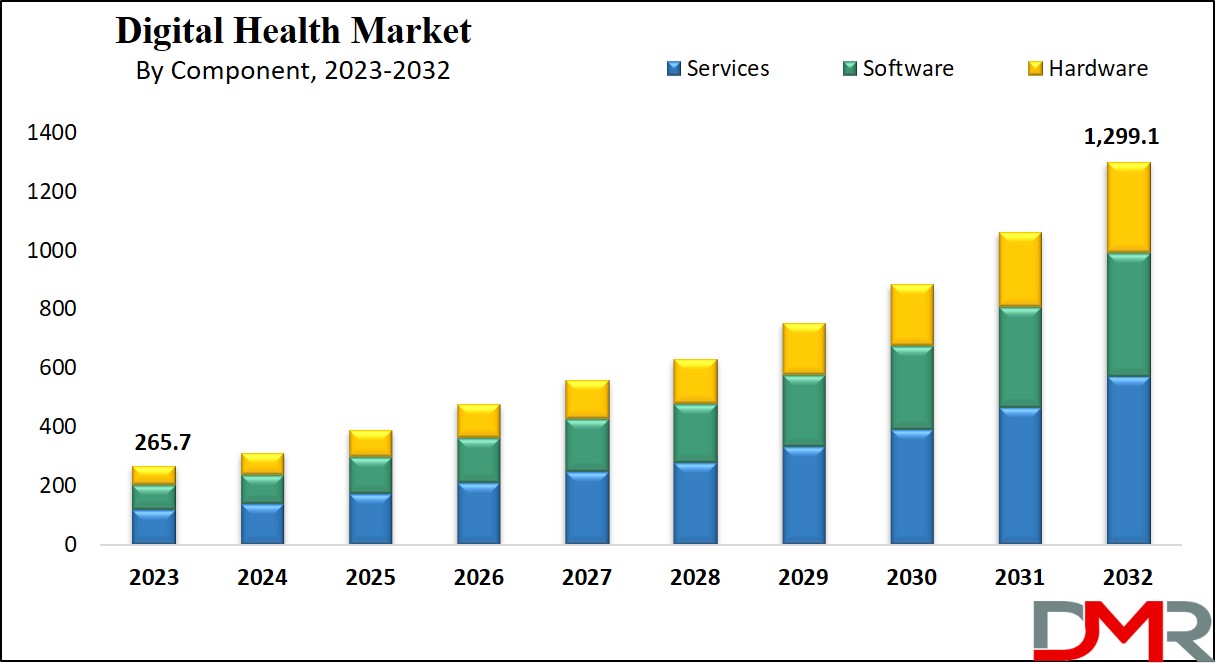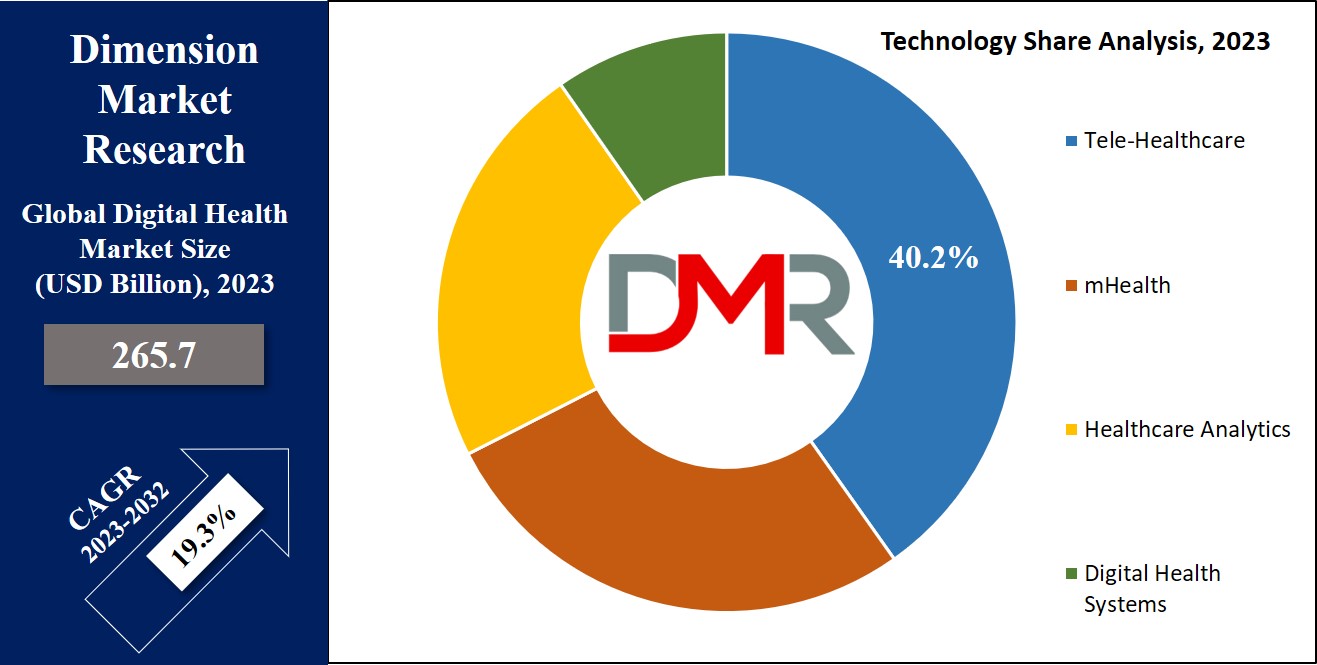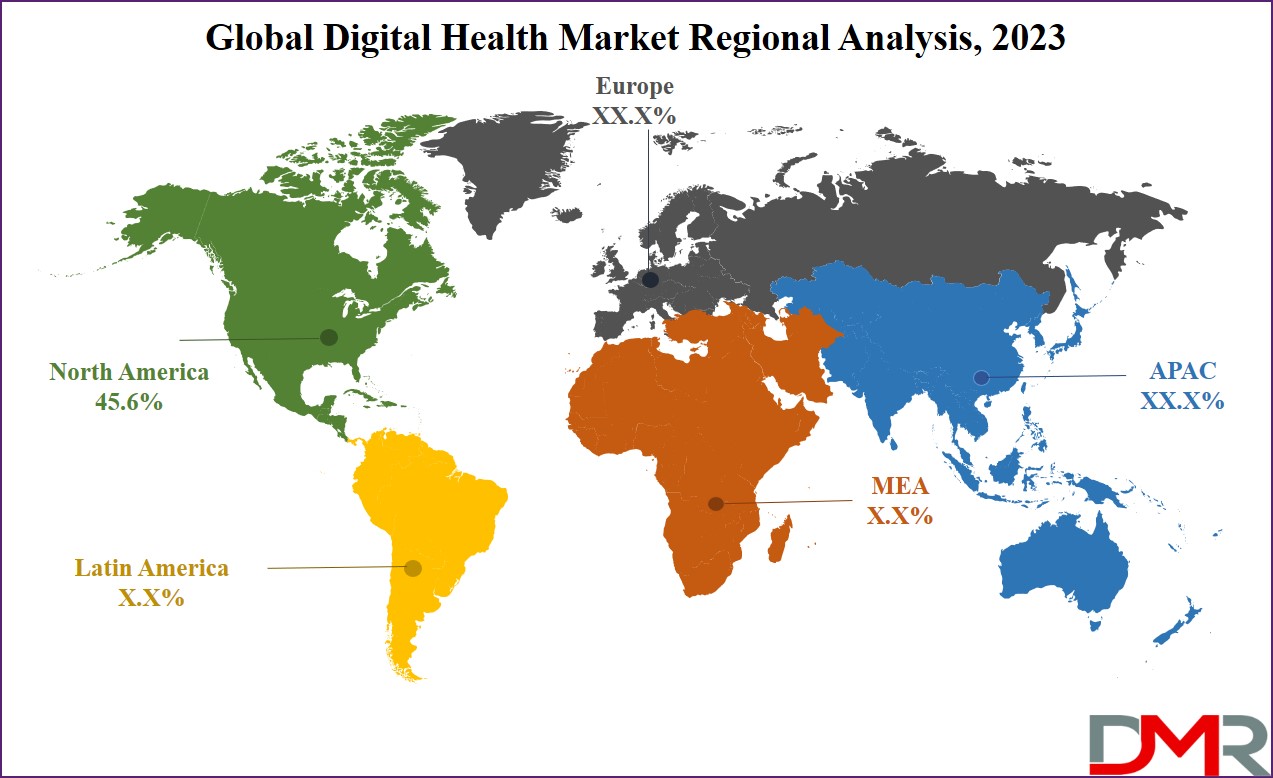Market Overview
The Global Digital Health Market is expected to reach a value of USD 265.7 billion in 2023, and it is further anticipated to reach a market value of USD 1,299.1 billion by 2032 at a CAGR of 19.3%. The market has seen a significant increase in the recent past and is predicted to grow significantly during the forecasted period as well.
Digital health utilizes technology like wearables, smartphones, & electronic health records to enhance patient engagement, healthcare delivery, & health outcomes. It includes digital care programs, and an integration of digital technologies with health & society, focusing on improving healthcare efficiency and personalize medical treatment.

The term "digital health" has gained popularity due to the higher use of platforms like telehealth software & mobile health in hospitals & nursing homes. These technologies provide real-time healthcare services, making medicine more precise & tailored to individual needs.
The digital health sector continues to thrive, driven by groundbreaking innovations and strategic collaborations. Recent events and conferences, such as HLTH 2024, spotlighted advancements in AI-powered diagnostics and
telemedicine. Global digital health investments reached $50 billion in 2024, reflecting a 12% YoY growth.
A recent survey highlighted that 75% of patients prefer digital tools for managing chronic conditions. Meanwhile, mergers between tech giants and healthcare providers are reshaping care delivery, emphasizing personalized medicine and interoperability, underscoring the sector’s transformative potential in modern healthcare.
Key Takeaways
- Market Growth: The global digital health market is projected to grow from USD 265.7 billion in 2023 to USD 1,299.1 billion by 2032, at a 19.3% CAGR, driven by rising technology adoption and healthcare innovation.
- Adoption Drivers: Demand for personalized healthcare solutions, enabled by digital tools and data-driven decision-making, is a primary growth driver. Early intervention and tailored treatments are becoming standard.
- Regional Strength: North America holds the largest market share at 45.6%, thanks to early adoption, smartphone penetration, and strong digital health infrastructure. Asia Pacific is expected to grow rapidly as eHealth investment rises.
- Competitive Landscape: Intense competition is seen as established players and startups focus on telehealth and AI-powered solutions. Strategic collaborations and fresh platforms are reshaping the industry landscape.
- Service Dominance: The services segment commands the highest revenue share in the digital health market due to demand for staffing, training, and maintenance, and is further propelled by rapid software solution adoption.
Use Cases
- Remote Patient Monitoring: Enables healthcare providers to track patient vitals and chronic conditions in real-time, reducing hospital visits and improving proactive care, especially for elderly or high-risk patients.
- Telemedicine Consultations: Facilitates virtual doctor-patient interactions, making healthcare more accessible in rural or underserved regions, and decreasing the burden on physical clinics and hospitals.
- Personalized Treatment Planning: Leverages electronic health records and AI algorithms for customized healthcare solutions, ensuring treatments are specifically tailored to individual genetics, lifestyle, and medical history.
- Chronic Disease Management: Supports ongoing management for conditions like diabetes or cardiovascular diseases through smart wearables and mobile health apps, enhancing patient engagement and early intervention.
- Healthcare Analytics Platforms: Utilizes big data analytics and machine learning to forecast disease trends, optimize resource allocation, and support decision-making for hospitals and public health organizations.
Market Dynamic
The global adoption of digital health technologies is on the growth, mainly driven by the increasing demand for customized healthcare solutions tailored to individual patients. Personalized healthcare involves creating treatment plans specific to each patient, considering factors such as genetics, lifestyle, & environmental influences.
Digital health tools like health information exchanges (HIEs), electronic health records (EHRs), & machine learning algorithms equip healthcare providers with a wealth of patient data, allowing the discovery of customized treatment options, which facilitates early intervention by medical professionals, potentially preventing the growing health conditions, & provide significant growth opportunities in the global digital health technology market.
However, in some areas, limited access to smartphones & mobile devices, mainly due to cost or availability issues, can create challenges for patients using wearables & health apps for remote monitoring. In addition, poor internet connectivity in remote or rural areas may hinder access to telemedicine services & remote health data sharing, restraining the application of digital health technologies & complicating patient care in these regions.
Research Scope and Analysis
By Component
The global digital health market as a component is categorized into services, software, and hardware, of which, the service segment commands the largest share of revenue which is driven by the rising demand for many services like staffing, training, installation, maintenance, & more.
Further, the current advancements in software solutions lead to higher requirements for deployment & training services. Also, key players offer a variety of pre-installation & post-installation services, either as part of packages or separately, which contributes to the growth of this segment.
Moreover, the software segment is predicted to experience rapid growth during the forecasted period, with the main driver behind this growth is the quick adoption of software solutions by hospitals, patients, healthcare providers, & insurance payers. In addition, the coupling of machine learning techniques, deep learning, & AI functionality improves the customization of healthcare, further driving market expansion. AI & machine learning are included in digital health to help in remote patient analysis, &
healthcare chatbots are installed to give up-to-date healthcare information.
By Technology
The tele-healthcare sector takes the lead in 2023, claiming a substantial share of market revenue. Telehealth services are growing due to the growth in the demand for accurate health & fitness monitoring, secure healthcare data storage, & real-time population management. The constant enhancement of telehealth hardware & software components contributes to service expansion.
Further, the growing trend of software enhancements, including a variety of healthcare applications, drives the market growth. The emergence of diverse platforms for monitoring, diagnosis, & disease prevention adds to the market's expansion, particularly as investments in digital infrastructure grow, mainly in developing countries. As players in the market are innovating to deliver their clients with new service options, positively impacting market growth, this segment is expected to experience the fastest growth during the forecast period.
Also, remote patient monitoring is gaining traction due to the rising number of chronic conditions like diabetes & cardiovascular diseases, along with high technological advancements. The global aging population growth is also boosting demand for
remote patient monitoring services, assisted by the inclusion of such features in many platforms. Government backing & policies that advocate healthcare digitization, along with high investments in healthcare IT, play a major role in driving the tele-healthcare segment expansion.

The Digital Health Market Report is segmented on the basis of the following
By Component
- Services
- Software
- Hardware
By Technology
- Tele-healthcare
- mHealth
- Wearables
- mHealth Apps
- Services
- Healthcare Analytics
- Digital Health Systems
- EHR
- E-Prescribing Systems
Regional Analysis
North America stands out as the dominant market leader in 2023, capturing a major
45.6% of the market revenue share. North America's early adoption of smart healthcare solutions, including smart wearables, mobile apps, & eHealth services like EHR & telemedicine, has enabled people to access critical healthcare information remotely, mainly for managing serious & chronic conditions.
The region's growth is driven by factors like the high proliferation of smartphones, advances in network coverage, growth in chronic diseases, a highly elderly population, growth in healthcare costs, a shortage of major caregivers, & an increase in the need for improved prevention & management of chronic illnesses.
Also, the Asia Pacific region is expected to the rapid growth during the forecast period, which is underpinned by the growth in the adoption of eHealth platforms & growing healthcare investments in the region.
Government healthcare funding & the ongoing demand for remote patient monitoring & telehealth services are anticipated to propel the industry forward in the Asia Pacific. In addition, the active participation of major market players in the region has grown the adoption of digital applications & platforms, further augmenting healthcare accessibility & services in the area.

By Region
North America
Europe
- Germany
- The U.K.
- France
- Italy
- Russia
- Spain
- Benelux
- Nordic
- Rest of Europe
Asia-Pacific
- China
- Japan
- South Korea
- India
- ANZ
- ASEAN
- Rest of Asia-Pacific
Latin America
- Brazil
- Mexico
- Argentina
- Colombia
- Rest of Latin America
Middle East & Africa
- Saudi Arabia
- UAE
- South Africa
- Israel
- Egypt
- Rest of MEA
Competitive Landscape
The digital health market experiences strong competition, with established leaders introducing fresh platforms & new entrants joining to cater to the growing digital demand in healthcare. In addition, numerous global companies are investing in telehealth technology to assist healthcare providers & gain a bigger slice of the rapidly expanding market, leading to intense competition within the industry.
In October 2023, AdvaMed, the Medtech Association, introduced the establishment of AdvaMed Digital Health Tech, the newest division dedicated to representing digital medical technology firms & advocating for the major role of data & digital technology in reshaping healthcare. Under the leadership of Shaye Mandle, this group acts as a think tank & organizer for the sector, concentrating on four key policy aspects, which are payment & healthcare delivery, regulatory matters, responsible data management & privacy, and cybersecurity.
Some of the prominent players in the global Digital Health Market are:
- Cisco System Inc
- AT&T Inc
- iHealth Lab Inc
- Cerner Corp
- McKesson Corp
- Athenahealth Inc
- EClinicalWorks
- BioTelemetry Inc
- Allscripts Healthcare LLC
- GE HealthCare
- Other Key Players
Recent Developments
- In July 2025, Blue Cloud Softech Solutions Limited launched BluHealth Platform v2.0, introducing advanced AI-powered tools for enterprise healthcare management and diagnostics.
- In June 2025, Teladoc Health announced the acquisition of Catapult Health for $65 million in cash to enhance preventive care and virtual checkup platforms.
- In January 2025, DecisionRx secured $100 million in debt financing to accelerate deployment of its AI-enabled medication management platform in North America.
- In June 2024, Foodsmart raised $200 million in Series D funding to grow its digital nutrition and telehealth services across new markets.
- In April 2024, Formation Bio raised $375 million in Series D funding, supporting the growth of its digital platform for data-driven clinical trial management and virtual research.
Report Details
| Report Characteristics |
| Market Size (2023) |
USD 265.7 Bn |
| Forecast Value (2032) |
USD 1,299.1 Bn |
| CAGR (2023-2032) |
19.3% |
| Historical Data |
2017 - 2022 |
| Forecast Data |
2023 - 2032 |
| Base Year |
2022 |
| Estimate Year |
2023 |
| Report Coverage |
Market Revenue Estimation, Market Dynamics, Competitive Landscape, Growth Factors and etc. |
| Segments Covered |
By Component (Services, Software, and Hardware), By Technology (Tele-healthcare, mHealth, Healthcare Analytics, and Digital Health Systems) |
| Regional Coverage |
North America – The US and Canada; Europe – Germany, The UK, France, Russia, Spain, Italy, Benelux, Nordic, & Rest of Europe; Asia- Pacific– China, Japan, South Korea, India, ANZ, ASEAN, Rest of APAC; Latin America – Brazil, Mexico, Argentina, Colombia, Rest of Latin America; Middle East & Africa – Saudi Arabia, UAE, South Africa, Turkey, Egypt, Israel, & Rest of MEA |
| Prominent Players |
Cisco System Inc., AT&T Inc, iHealth Lab Inc, Cerner Corp, McKesson Corp, Athenahealth Inc, EClinicalWorks, BioTelemetry Inc, Allscripts Healthcare LLC, GE HealthCare, and Other Key Players |
| Purchase Options |
We have three licenses to opt for: Single User License (Limited to 1 user), Multi-User License (Up to 5 Users), and Corporate Use License (Unlimited User) along with free report customization equivalent to 0 analyst working days, 3 analysts working days and 5 analysts working days respectively. |
Frequently Asked Questions
The Global Digital Health Market is estimated to reach USD 265.7 billion in 2023, which is further
expected to reach USD 1,299.1 billion by 2032.
North America dominates the Global Digital Health Market with a share of 45.6% in 2023.
Some of the major key players in the Global Digital Health Market are Cisco System Inc, GE Healthcare,
AT&T Inc, and many others.
The market is growing at a CAGR of 19.3 % over the forecasted period.